
May was a very good month for new to me games.
I got one of my new games to the table, played a couple that I’ve been dying to play for a while now, and was introduced to a few that I didn’t even know existed.
That’s the best thing about being part of the Cult of the New to Me!
New games are great, but new to me games are just priceless.
Even better when they are both, am I right?
This month has a smattering of everything, from a small card game to a new take on an old sci-fi book franchise, to classical music!
The Cult wasn’t very happy about all of the games being from the 2020s, but since only one was actually from 2025, that appeased them somewhat.

It did help that I bought them all cars, so that should satisfy them for at least this month.
My wallet isn’t very satisfied, though.
Think of all those new games I won’t be buying!
So without further ado (all of my ado was eaten by a vicious sandworm anyway), let’s begin!
Dune: Imperium – Uprising (2023 – Dire Wolf Digital) – 1 play

Designer: Paul Dennen
Artists: Clay Brooks, Derek Herring, Raul Ramos, Nate Storm
Players: 1-6
Add another BGG Top 100 game play to my list!
And this one won’t even be in danger of falling off, since it’s No. 12 right now.
Dune: Imperium – Uprising is the standalone sequel/expansion/something else to the very cool Dune: Imperium, a game that I own with both expansions but have only played a couple of times on the table.
(Though many plays on the app).
We also included some aspects of the Bloodlines expansion, so I’ll try to make clear which is which below.
Uprising has the same basic mechanics of playing a card to place a worker, but changes those locations as well as adding some cool stuff.
Like sandworms!
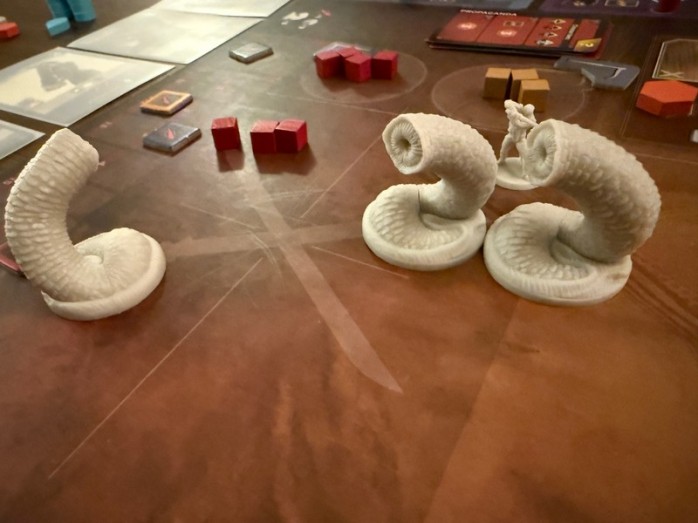
Yes, if you are able to get some worm hooks (or whatever they’re called), you can go to another space to corral a worm for that round’s combat.
Bloodlines also adds the ability to recruit Sardaukar Commanders into your barracks (and then even though they “die” at the end of the combat, they are available for you to purchase again).
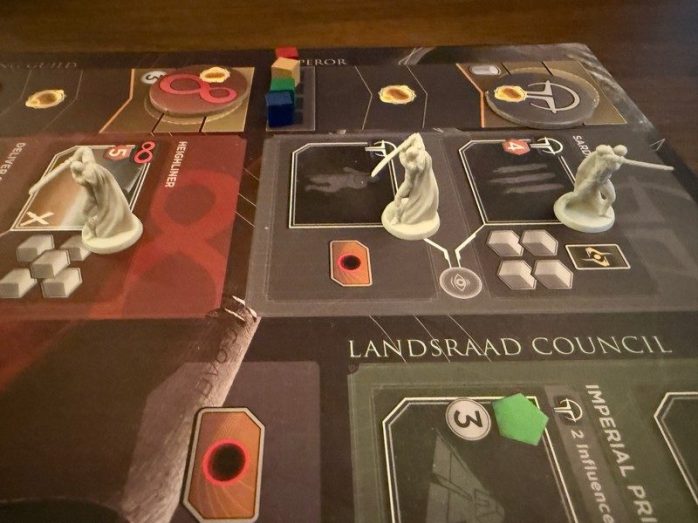
These Commanders give you a special ability when you hire them, and if you hire more than one, you get all of the special abilities you’ve chosen each time even just one of them is in combat!

(of course the photographer did not take a picture of those ability tiles, so I can’t show you. The new photographer has also been sacked)
Another new addition to the game are contracts.
These are contracts that you can choose and, when you fulfill them, you get the bonus that’s on them.
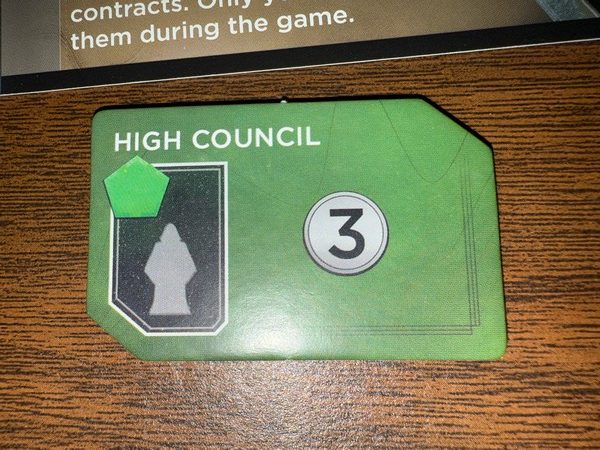
These can give you more incentive to go to spaces you might not have gone to anyway, or point a way to a strategy you might want to use.
This one will give you three money when you go to the High Council space.
There are also spies you can place in a location, which may allow you to go to an already-occupied space if your spy is there (removing the spy). Or there are some other spy effects as well.
Finally, the new skirmish cards and ideas are very cool.
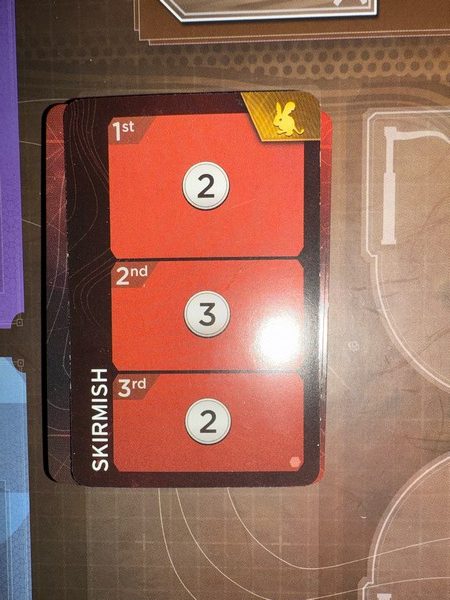
Each skirmish now has a symbol on it.
The winner of the skirmish may not get as much stuff as second place, but they get the card.
For each pair of icons, you get a point.
That’s 10% of the way to a win!
Each player starts with a card with a symbol, meaning that you only need one skirmish win (of the right type) to get that first point.
There’s more, but maybe I’ll get some more plays in and actually do a review of it.
In the meantime, I really enjoyed this one.
More than the original plus expansions?
Maybe?
Lacrimosa (2022 – Devir Games) – 2 plays

Designers: Gerard Ascensi, Ferran Renalias
Artists: Jared Blando, Enrique Corominas
Players: 1-4
Games about historical figures aren’t that uncommon, but I’m struggling to think of any about historical musical figures.
Scratch that topic off the list of missing ones!
Lacrimosa is about the life of Mozart, as well as completing his final Opus Requiem, which he died before he could complete.
Players are patrons of the late composer who not only are commissioning two other composers to help complete it, but also are reliving Mozart memories of his travels, the music he created and performed, and other memories as well.

This is all realized on the board and through an interesting card play mechanism.
Essentially, you will always have nine cards in your deck.
When you do an action to get one of the action cards in the market (as opposed to opuses, which are different), you will be getting rid of one of your other ones (the one that you played for story income, so you have to choose wisely).
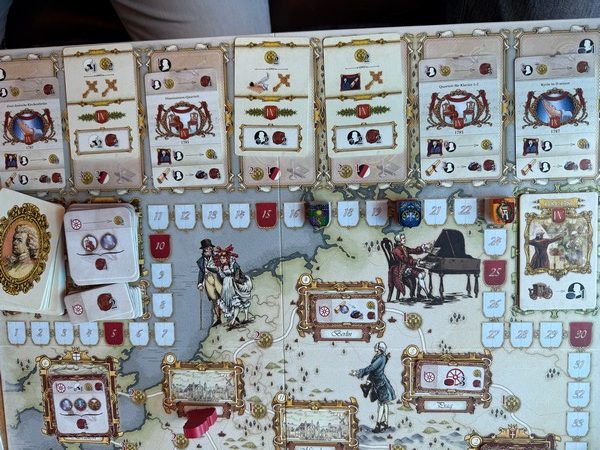
Each round gives you four actions where you will play two cards: one as the action (the top portion of the card) and one as “story point income” for the next round.
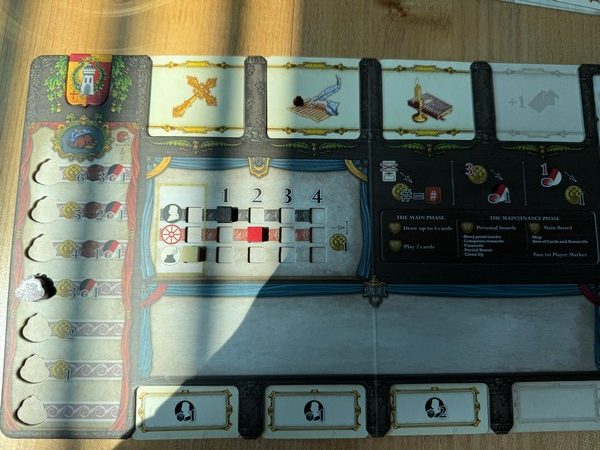
That bottom card, you are foregoing the action for that round as it’s already in use.
The boards are actually really cool, letting you slide the cards in so only the relevant parts are showing.
The actions you can take will let you get another card, or perhaps use story points to purchase an opus that Mozart had played.

Another action is to perform or sell one of these opuses, for either money or points (or both!).
You can send Mozart travelling around Europe by paying money and experience the new city with travel story points.
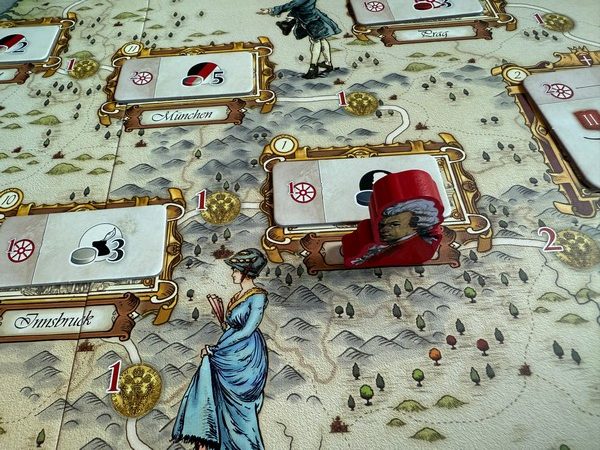
Each city you end in will give you some benefit when you spend the travel story points, and they can be quite lucrative!
Finally, you can commission one of the two composers chosen for this game (out of four) to help complete the Requiem, through different sections of it and different instrument types.

This will give you an immediate bonus and scoring at the end of the game.
This ends up being a bit of area majority scoring, based on which composer has contributed the majority to each movement and which patron has actually commissioned that.
It’s a really cool mechanism that I greatly enjoyed.
There’s a bit more to it than that, but let’s leave that for the review.
Lacrimosa didn’t make much of a buzz when it came out in 2022 and I bought it for a steal from the publisher late last year. Now I can’t even find it on the Devir site, so I’m not sure if that means it won’t be reprinted or if it’s just not in stock.
Either way, this game is actually very good and I can’t wait to play it again.
Molly House (2025 – Wehrlegig Games) – 1 play

Designers: Jo Kelly, Cole Wehrle
Artist: Rachel Ford
Players: 1-5
Molly House is one of the early Zenobia Award winners.
What’s that?
From the Zenobia Award page:
“The Zenobia Award seeks to attract and reward more diverse design talent in order to improve historical tabletop game design and participation and to diversify historical topics simulated in published hobby board games. It seeks to apply the Derby House principles for diversity and inclusion in professional wargaming to hobby gaming.”
In the case of Molly House, the game has “players take the roles of the gender-defying mollies of early eighteenth century London.”
I think the blurb on BGG can describe this game better than I can:
“Over the course of an hour, players will draft hands of vice cards representing the different gestures, desires, and encounters that were frowned upon by the Society for the Reformation of Manners, a citizen group that sought to stamp out any behavior it deemed deviant in late 17th and early 18th century London. These cards allow players to host festivities with the help of their fellow mollies and create joy. But, those same cards can also lead players to be arrested and to the ultimate ruin of the molly house.”
The card play in this game is really interesting, sometimes confusing, but always immersive.
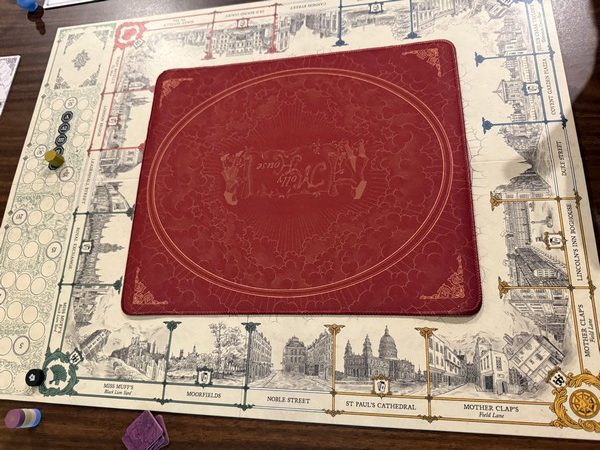
The board represents areas of London, which some more moralistic sorts may have considered “seedy” but were really just inhabited by those people who wanted to live their lives without being persecuted for their orientation.
Believe it or not, this actually is a roll and move game!
But don’t hold that against it.
You roll two dice and can move the value of one die or both dice.
One side of the die actually has a “discard a card from the row” icon and allows you to stay where you are (i.e. move zero spaces).
Depending on where you land, you may be able to pick up something useful, or maybe some vice cards, or even throw a party if you happen to land on one of the four corner houses.
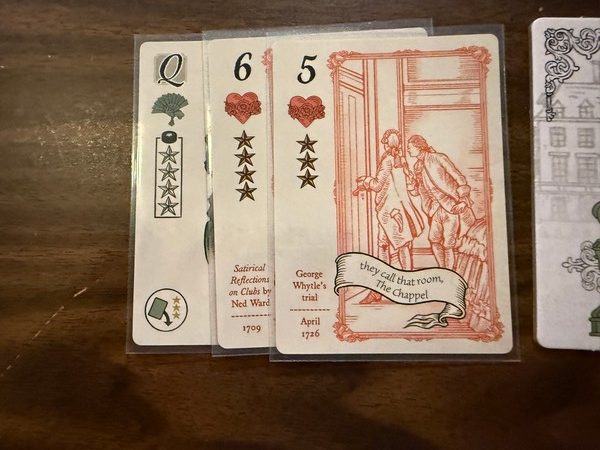
Playing cards will add to your reputation in one of the four houses (denoted by colour and symbol for those who are colour-blind).
Reputation can be both good and bad.
It will score you points during the parties, as you are an established patron of that house.
But if you fall under suspicion, that reputation can harm the house and perhaps yourself as well.

Parties are a fascinating aspect of the game, as you are trying to form certain sequences by playing cards to it.
The House plays a random card and then players play their own card. Then the same happens for the second round, though players can pass (except the player who threw the party). If you pass, you can’t play any more cards.
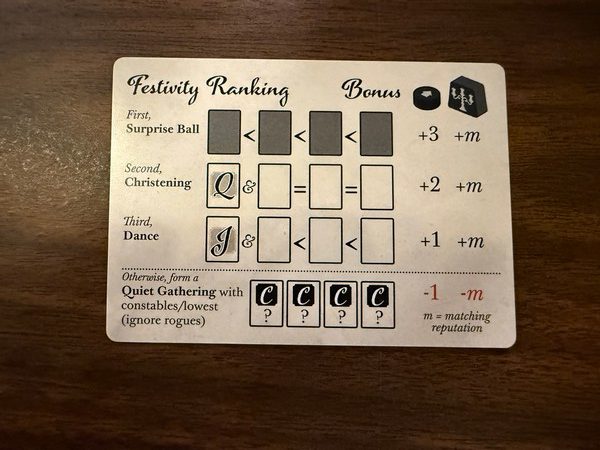
Depending on what the best sequence is for points, the required cards are pulled together and whoever played them gets points equal to their reputation in that house.
Unchosen cards end up going into the Gossip discard pile (as opposed to the regular discard pile).
Each round when the deck is empty, the Gossip pile is shuffled, one third of it is removed, and then the rest of the cards are revealed to see how aware the authorities have become to the activities in that house.
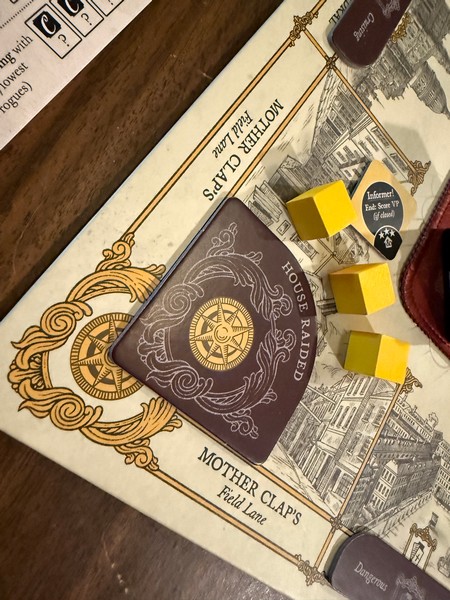
Once a house has seven cubes, it’s been raided.
Whoever has the most reputation in that house gets a Major Indictment.
Second highest gets a Minor one.
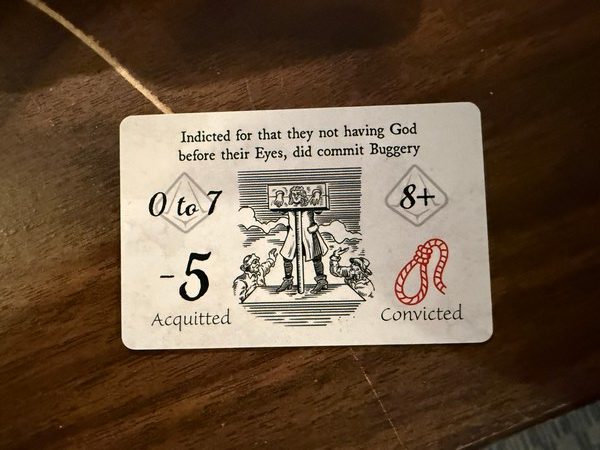
These are not good.
Just because a house has been raided doesn’t mean that it’s free from suspicion.
The authorities can still collect evidence of even more immoral activities.
If the raided house collects seven more evidence cubes, that will trigger game end at the end of the round.
The intriguing thing about this game is that the players who gained indictment cards will also place an encounter token in the nearest house to where their pawn is on the board.
Three of these tokens are loyalty ones, but one is an informer.
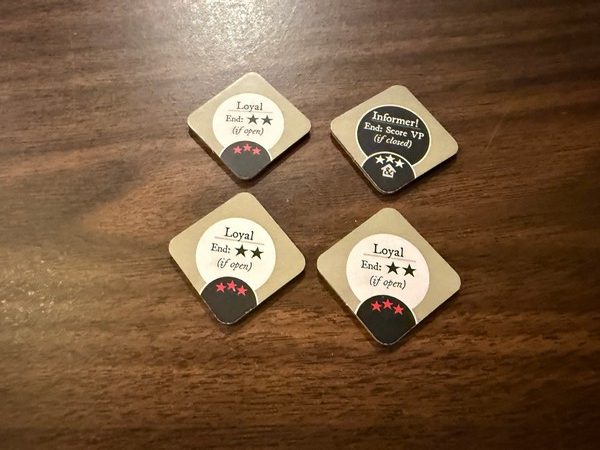
You could be an informer on one of the houses, mainly because the authorities got to you in their sweep and put pressure on you.
The game ends when all four houses have been raided, one house has seven additional evidence cubes on it after being raided, the “Community Joy” token passes a certain point (“Joy” = “points”) or at the end of five rounds.
If the Community’s not joyful after five rounds but the game hasn’t ended for other reasons, then the game ends with “community atrophy”, meaning all players lose.
There’s a lot more to this game than I can go into here, but it’s a really neat illustration of a side of life and history that isn’t talked about, at least not much publicly.
The Zenobia Awards are great things to bring under-represented topics and groups into the gaming community.
Molly House is a winner in that respect.
It’s also a winner because, at least after my first play, it’s a great game.
Fishing (2024 – Rio Grande Games) – 1 play

Designer: Friedemann Friese
Artist: Maren Rache
Players: 3-5
We all know I love trick-taking games, so when Fishing was mentioned to me, I was really interested in knowing what it brought to the genre.
Would it be anything new?
I shouldn’t have doubted, because Fishing actually brings a lot of cool stuff, offering a couple of different avenues of winning.

The game goes over eight rounds and starts with everybody getting dealt cards from the starting deck.
The number of cards players start with each round is dictated by the round (and maybe player count too? I’m not sure).
It’s a standard must-follow trick-taking game where you must follow the led suit if you have any.
There is a green trump suit, though I don’t think any of those cards come in until later.
What does that mean?
As you win tricks, they’ll get put on your fish card (on the left in the picture above).
Each card will get you a point, but the cards you won are now in your deck.
Next round, you’ll draw cards from your deck until you can’t and you still need more, or until you reach the number of cards for that round.
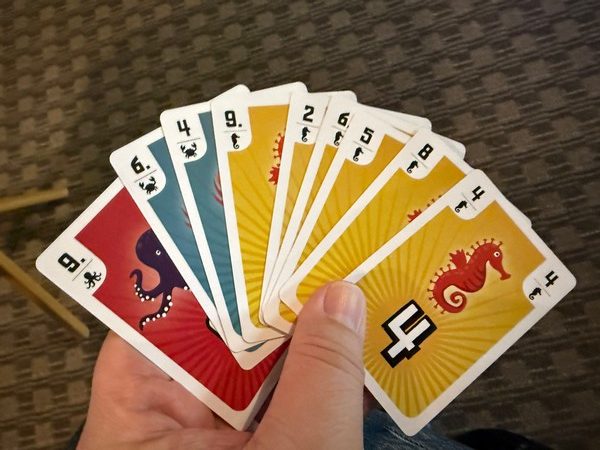
Any additional cards that you need (say you only won one trick so you only have 4 cards in your deck) are drawn from a separate, much-stronger deck.
This deck will get even stronger as players take cards from it.
If you win a lot of tricks in a round, you will get a lot of points!
But then it will be a while before you can draw any of these stronger cards, because you have to use up what’s in your deck first.
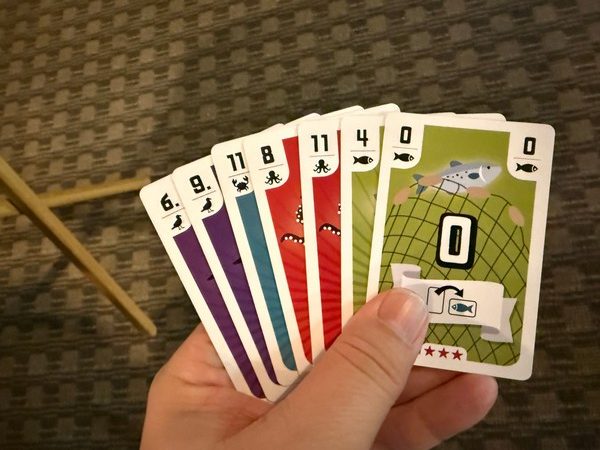
Some of those stronger cards either have higher numbers or other abilities.
And some of them are actually trump!
The “0” ability will let you take one card from the trick as your own, even though another player has won it.
So take that nice high card they played!
Throughout the game you’re facing a tug of war between “do I want a lot of points this round?” and “do I want to forego points this round to get a bunch of great cards for the next round?
In my play of the game, I was 35 points behind the two leaders going into the final round.
In Round 7, I didn’t win a single trick, which meant all of my cards (I believe there are 12 in the final round?) were from the strong deck.
I ended up losing by 7 points, picking up 28 points on the eventual winner.
Probably shouldn’t have waited so long, but that’s just an example of that decision you have to make.
I really enjoyed this one and would love to play it again.
Middle Ages (2024 – Studio H) – 1 play
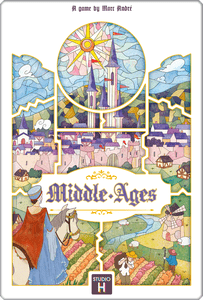
Designer: Marc André
Artist: Claire Conan
Players: 2-5
I have fond memories of a quick little card game called Majesty: For the Realm, a game where you are drafting cards to go into your medieval village.
It was quick, it was easy, and heck, I even reviewed it!
Studio H has now come out with a revision of the game, using tiles and incorporating a few different rules than the original, but you can definitely see its pedigree.
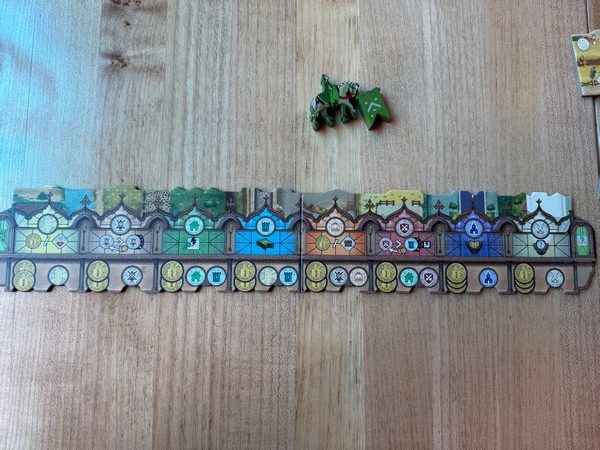
Once again, each player has a row of building types in their village, though this time they are tiles and not cards.
Unlike the draft row in the original game, where cards moved left to fill the empty space, though, Middle Ages has multiple draft rows with a drafting mechanism very much like Kingdomino.
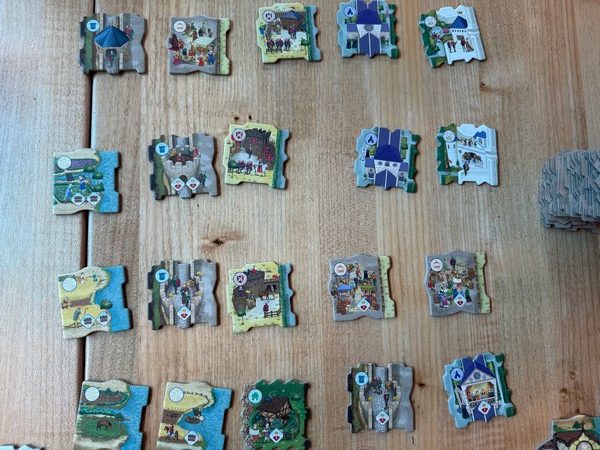
The tiles in each row are sorted by number from left to right. When you take a tile, you will move your player piece to a tile on the next row that you want to claim.
Drafting goes from left to right, so the “weaker” the tile is you take (the lower numbered), the more choice you get for the next round.
If you draft first, you have all 5 (in a 4-player game) tiles in the next row to claim!
If you draft last, you have two choices.
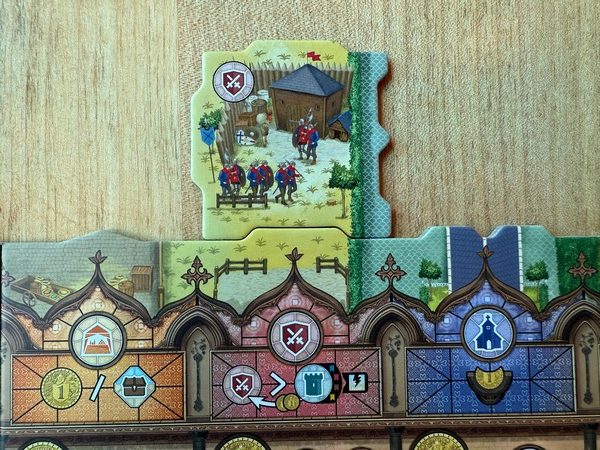
The tiles are custom cut to fit directly into your village so you know you’re putting it in the wrong place if it doesn’t fit.
There is some take that, which will cost other players money (that they give to you) or even the leftmost building in their village, but there are ways to protect yourself against that as well.
When you place the tile, you will get an effect of some kind (the barracks above is what may trigger the building loss in others) and then you will get money in some fashion.
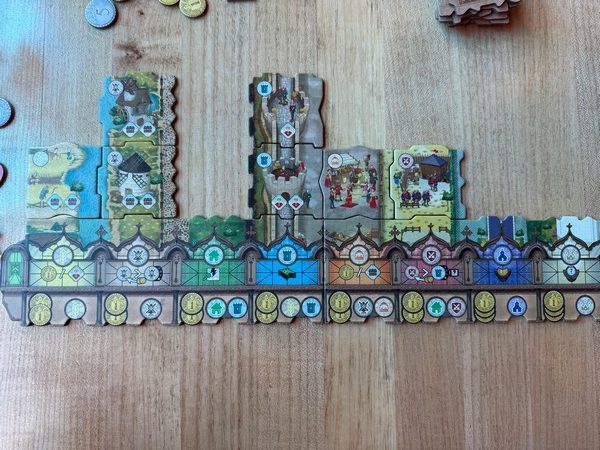
In the picture above, placing an orange building will get you 1 coin per chest anywhere in your village, and then 2 coins per market and windmill you have.
The goal of the game is just to collect money.
You’re not using the money for anything (except paying your opponent when they attack you if you’re not able to defend yourself).
They are just points.
At the end of the game, you’ll have a beautiful village!

And hopefully have a lot of money too.
The production on this game is amazing and it still packs the same amount of fun as the original.
I do like the drafting change as well.
I think it works better for this game.
Middle Ages is a hit for me, at least after one play.
Nana (aka: Trio) (2021 – Cocktail Games) – 1 play
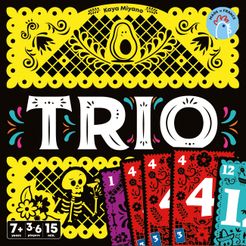
Designer: 宮野 華也 (Kaya Miyano)
Artists: Laura Michaud, 別府さい (Sai Beppu)
Players: 3-6
Trio (also called Nana) is a short little card game where you are trying to form trios of cards to win the game!
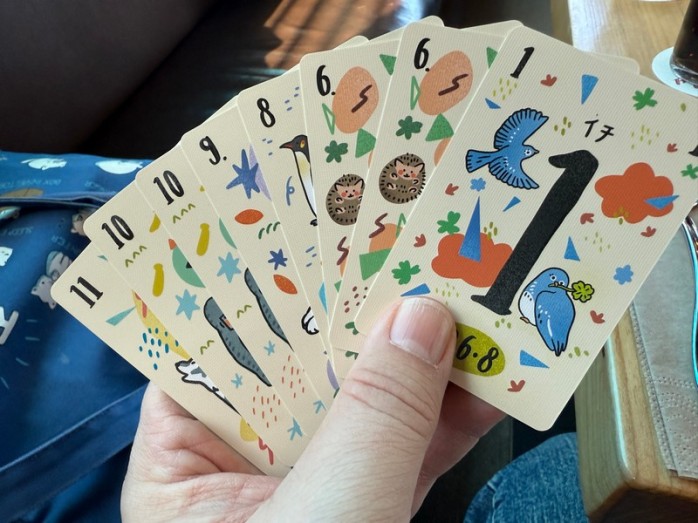
The deck has 36 cards, three sets of cards labelled 1-12
The number varies by player count, and then the rest of the cards are placed face down on the table.
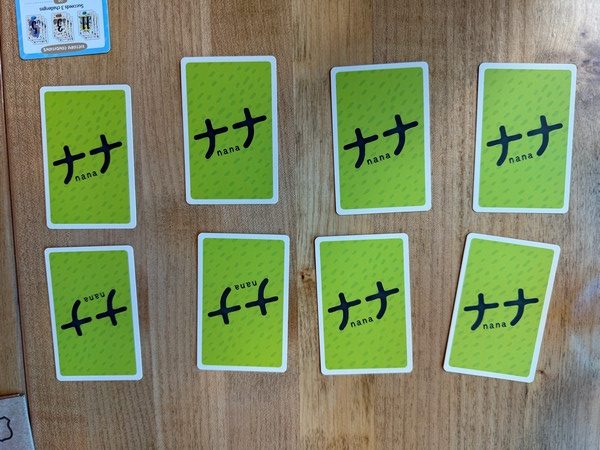
Players have to put their hand cards in numerical order.
Then, players take turns calling for cards.
You can ask another player to show their highest or lowest card (the one on the left or right of their hand).
They can also flip over one of the face-down cards.
Or they can play one of their own.
They keep doing that until the revealed card doesn’t match the previously-revealed one(s) or until they get all three of the same number.

Somebody wins when they either get three trios or they get the 7 trio (because it’s the middle number and probably hardest to get).
There’s also the “spicy” mode where if you get two trios that add/subtract to make 7, you also win!
So that would be a 6+1 or 8-1 and so on.
(It’s nice that each card shows what it would pair up with to win this way, like the 11 above and a 4).
We played this slightly wrong, so that it could have been possible to actually be locked out, but it did end with a winner.
It’s a fun little game, takes about 10 minutes at most, maybe 15?
Great filler.
Pax Illuminaten (2024 – Ion Game Design) – 1 play

Designer: Oliver Kiley
Artist: Madeleine Fjäll
Players: 1-4
Pax Illuminaten was my last play in May and it’s quite the intriguing card game, especially because there’s lots of intrigue!
The cards are kind of multi-use, in that they make up the “map” on the table, as well as being able to play to your Scheme for added benefits or favours.
The map is different depending on player count, but we played with four players.
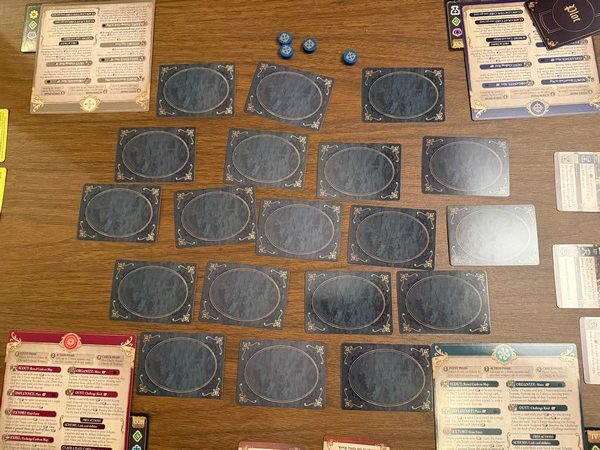
The cards are laid out face-down and each player starts at the corner of it (interestingly, your player mat is also actually a “card” on the map that only you can interact with).
Players are “Areopagites” in the Order of the Illuminati in 1976, trying to foster Enlightenment ideas from out of the shadows of oppression by the Holy Roman Empire.
The winner of the game will be the player who successfully completes two Plot cards. There are two public plot cards and then each player has one private one that only they can fulfill.
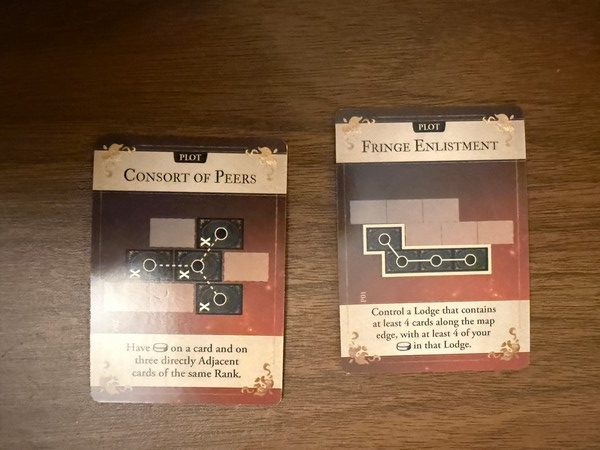
You’re doing that by trying to spread influence through the lodges of various factions, represented by cards that represent various historical figures.
You can do two main actions on your turn (which can be the same action if you want), and you will use these actions to build the map and move your influence out to those cards.
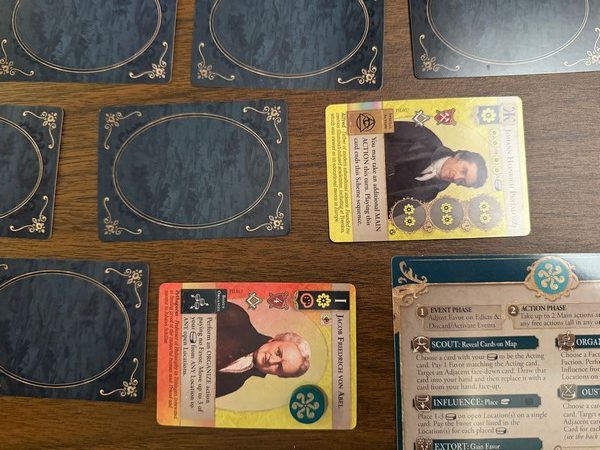
Scouting will not only uncover a card that you are adjacent to (with your influence) but it will allow you to replace that card with a card in your hand if you wish.
Each card will have 1-3 circles on it that you can pay the appropriate favour type to placed your influence dis on it.
Lodges are formed when 3+ cards are adjacent to each other with the same faction (many cards are two factions) and control of that lodge is whoever has the most of their discs in it.
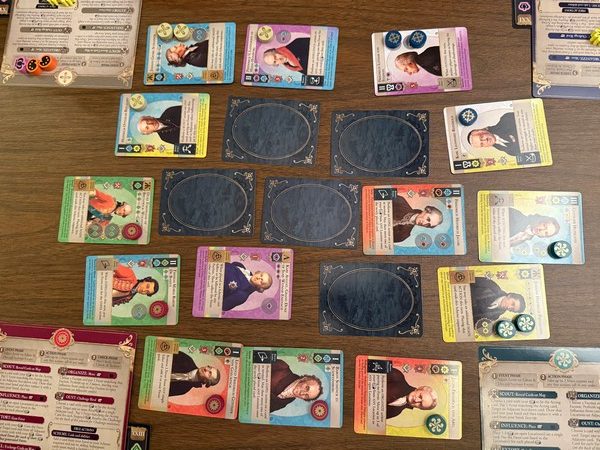
Since cards can be “expelled” from the map and replaced, it is possible for a lodge to go away, so that’s something to be wary of too.
You can even Oust somebody’s influence off of a card that you are adjacent to!
And move your own influence around the board too.
There are also Event cards that can come out if a Crown or Ace is played anywhere on a turn.
Some events are just events, but others are Edicts and must be played when drawn.
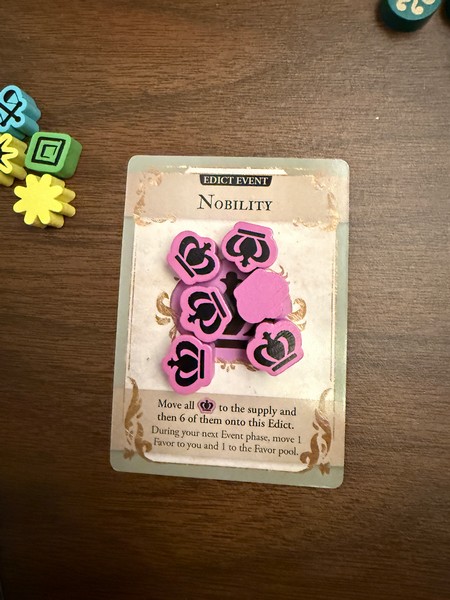
This allows you to accumulate a certain type of favour and as one comes to you each turn (and one is discarded), this edict will last for three turns.
When it’s empty, it’s discarded.
The game will end either when somebody successfully completes two plots or five of the edict cards have been discarded.
So you’re on a bit of a timer (there are six edicts in a twelve-card Event stack).
We played a few rules wrong, mostly minor changes (nothing as big as Shipyard!), and it was late in the evening. I was under a bit of a time crunch, so I don’t think I enjoyed this as much as I might have otherwise.
I would like to try it again with the proper rules and where time isn’t a factor.
But it is intriguing!
There you go, seven new to me games in March.
Quite unexpected!
What new to you games did you play in March?
If you haven’t told me already.
Let me know in the comments.